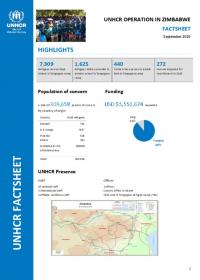Operations

OPERATIONS
Africa
- Central Africa and the Great Lakes
- Burundi
- Cameroon
- Central African Republic
- Congo
- Democratic Republic of the Congo
- Rwanda
- United Republic of Tanzania
- East and Horn of Africa
- Southern Africa
- West Africa
Americas
Asia and the Pacific
Europe
Middle East and North Africa
NEW: 2016 planning information has just been released. Budgets and population planning figures for 2016 and for previous years can be reviewed below. The French version will be published before the end of the year.
Location
{"longitude":29,"latitude":-19,"zoom_level":0}
Latest update of camps and office locations 1 December 2015. By clicking on the icons on the map, additional information is displayed.
Operational Highlights
Operational context and population trends
By the end of 2014, the country continued to face numerous social difficulties and significant economic challenges, including an over-extended financial sector, high public expenditures, and an underperforming mining, manufacturing and agricultural sector. In mid-March 2015, the Government announced the failure of up to 30% of the national food crops due to flooding and drought.
In 2015, progress to address the question of refugee status for some 2,000 rejected Congolese asylum-seekers from eastern Democratic Republic of the Congo (DRC) was achieved.
As of 31 December, 2014:
By the end of 2014, the country continued to face numerous social difficulties and significant economic challenges, including an over-extended financial sector, high public expenditures, and an underperforming mining, manufacturing and agricultural sector. In mid-March 2015, the Government announced the failure of up to 30% of the national food crops due to flooding and drought.
In 2015, progress to address the question of refugee status for some 2,000 rejected Congolese asylum-seekers from eastern Democratic Republic of the Congo (DRC) was achieved.
As of 31 December, 2014:
- Zimbabwe hosted 9,170 people of concern (refugees, asylum-seekers and other people of concern), which represents a slight increase from the end of 2013
- Around 86% of the people of concern reside in Tongogara refugee camp , while the rest are urban-based
- 79% originate from the DRC, 9% from Burundi, and 8% from Rwanda
- The average monthly influx of asylum-seekers remains stable, between 100 and 150 people per month. The ongoing conflict in eastern DRC continues to be the main driver of asylum-seekers into Zimbabwe
- There are no official statistics on the number of stateless people or people at risk of statelessness in Zimbabwe; however, as of 2010 it was estimated that between 20 to 30 % of the farm workers in Zimbabwe are of foreign descent (approximately 300,000 and 600,000 individuals).
- Strengthening the asylum regime and enhancing the capacity of the Government to independently manage refugee status determination (RSD), allowing gradual phase-out for UNHCR
- Searching for appropriate durable solutions for various refugee groups
- Improving documentation, including birth registration
- Reducing protection risks faced by people of concern, specifically refugee children
- Identifying people in need of international protection through regular border monitoring and visits to detention facilities, in the context of mixed migratory flows through Zimbabwe
- Remodelling camps into settlement that provide more opportunities for self-reliance
- Closing major gaps in the provision of adequate housing and infrastructure of schools to fully meet enrolment needs, improve quality of education and reduce drop-out rates
- Provide regular supplies of domestic fuel, including lighting in public spaces and household, in order to mitigate protection risks.
Stories
People of Concern
86%
Decrease in
2014
2014
| 2014 | 9,225 |
| 2013 | 67,107 |
| 2012 | 62,761 |

[["Refugees",6079],["Asylum-seekers",641],["Returned refugees",55],["Others of concern",2450]]
Loading ...
Budgets and Expenditure for Zimbabwe
< Back
{"categories":[2012,2013,2014,2015,2016],"budget":[7.75699344,7.45939881,6.82514325,5.80670135,6.434121642],"expenditure":[5.48046879,5.3211349,5.11835744,null,null]}
{"categories":[2012,2013,2014,2015,2016],"p1":[5.2627228,5.26126792,6.13458825,5.69170135,6.084611462],"p2":[0.50791654,0.37122646,null,0.115,0.34951018],"p3":[null,null,null,null,null],"p4":[1.9863541,1.82690443,0.690555,null,null]}
{"categories":[2012,2013,2014,2015,2016],"p1":[4.02366366,4.64729118,4.77045832,null,null],"p2":[0.15461312,null,null,null,null],"p3":[null,null,null,null,null],"p4":[1.30219201,0.67384372,0.34789912,null,null]}
Loading ...



